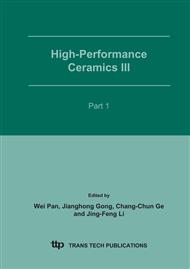p.1245
p.1249
p.1253
p.1259
p.1263
p.1267
p.1271
p.1275
p.1279
Effect of Cation Extraction on the Oxidation Resistance of Si3N4
Abstract:
A new method called cation extraction process has been applied to improve the oxidation resistance of silicon nitride ceramics with sintering additives. It is found that the high temperature oxidation rate of the Si3N4 ceramic treated by the process decreased remarkably in contrast to the oxidation rate of the Si3N4 without the process. The oxidation rate of Si3N4 ceramics with the cation extraction process is reduced more than 50% comparing with that of the Si3N4 ceramics without the process. The morphological characteristic and phase composition of the oxides were analyzed by means of SEM and XRD. The oxidation rate of silicon nitride after cation extraction treatment is determined by the quality of the “purified layer” formed below the pre-oxide scale. Thicker oxide layer formed in pre-oxidation, higher extraction temperature and longer extraction time are helpful to form a good “purified layer”.
Info:
Periodical:
Pages:
1263-1266
Citation:
Online since:
February 2007
Authors:
Keywords:
Price:
Сopyright:
© 2005 Trans Tech Publications Ltd. All Rights Reserved
Share:
Citation:


